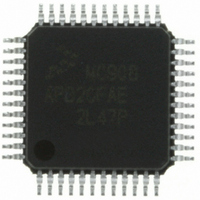MC908AP32CFAE Freescale Semiconductor, MC908AP32CFAE Datasheet - Page 217

MC908AP32CFAE
Manufacturer Part Number
MC908AP32CFAE
Description
IC MCU 32K FLASH 8MHZ 48-LQFP
Manufacturer
Freescale Semiconductor
Series
HC08r
Specifications of MC908AP32CFAE
Core Processor
HC08
Core Size
8-Bit
Speed
8MHz
Connectivity
I²C, IRSCI, SCI, SPI
Peripherals
LED, LVD, POR, PWM
Number Of I /o
32
Program Memory Size
32KB (32K x 8)
Program Memory Type
FLASH
Ram Size
2K x 8
Voltage - Supply (vcc/vdd)
2.7 V ~ 5.5 V
Data Converters
A/D 8x10b
Oscillator Type
Internal
Operating Temperature
-40°C ~ 85°C
Package / Case
48-LQFP
Controller Family/series
HC08
No. Of I/o's
32
Ram Memory Size
2KB
Cpu Speed
8MHz
No. Of Timers
2
Embedded Interface Type
I2C, SCI, SPI
Rohs Compliant
Yes
Lead Free Status / RoHS Status
Lead free / RoHS Compliant
Eeprom Size
-
Available stocks
Company
Part Number
Manufacturer
Quantity
Price
Company:
Part Number:
MC908AP32CFAE
Manufacturer:
Freescale Semiconductor
Quantity:
10 000
Company:
Part Number:
MC908AP32CFAER
Manufacturer:
Freescale Semiconductor
Quantity:
10 000
- Current page: 217 of 316
- Download datasheet (2Mb)
When configured as a slave (SPMSTR = 0), the MODF flag is set if SS goes high during a transmission.
When CPHA = 0, a transmission begins when SS goes low and ends once the incoming SPSCK goes
back to its idle level following the shift of the eighth data bit. When CPHA = 1, the transmission begins
when the SPSCK leaves its idle level and SS is already low. The transmission continues until the SPSCK
returns to its idle level following the shift of the last data bit. (See
In a slave SPI (MSTR = 0), the MODF bit generates an SPI receiver/error CPU interrupt request if the
ERRIE bit is set. The MODF bit does not clear the SPE bit or reset the SPI in any way. Software can abort
the SPI transmission by clearing the SPE bit of the slave.
To clear the MODF flag, read the SPSCR with the MODF bit set and then write to the SPCR register. This
entire clearing mechanism must occur with no MODF condition existing or else the flag is not cleared.
13.8 Interrupts
Four SPI status flags can be enabled to generate CPU interrupt requests.
Freescale Semiconductor
SPTE
Transmitter empty
SPRF
Receiver full
OVRF
Overflow
MODF
Mode fault
To prevent bus contention with another master SPI after a mode fault error,
clear all SPI bits of the data direction register of the shared I/O port before
enabling the SPI.
Setting the MODF flag does not clear the SPMSTR bit. The SPMSTR bit
has no function when SPE = 0. Reading SPMSTR when MODF = 1 shows
the difference between a MODF occurring when the SPI is a master and
when it is a slave.
When CPHA = 0, a MODF occurs if a slave is selected (SS is at logic 0) and
later unselected (SS is at logic 1) even if no SPSCK is sent to that slave.
This happens because SS at logic 0 indicates the start of the transmission
(MISO driven out with the value of MSB) for CPHA = 0. When CPHA = 1, a
slave can be selected and then later unselected with no transmission
occurring. Therefore, MODF does not occur since a transmission was
never begun.
A logic 1 voltage on the SS pin of a slave SPI puts the MISO pin in a high
impedance state. Also, the slave SPI ignores all incoming SPSCK clocks,
even if it was already in the middle of a transmission.
Flag
MC68HC908AP A-Family Data Sheet, Rev. 3
SPI transmitter CPU interrupt request
(SPTIE = 1, SPE = 1)
SPI receiver CPU interrupt request
SPI receiver/error interrupt request (ERRIE = 1)
SPI receiver/error interrupt request (ERRIE = 1)
(SPRIE = 1)
Table 13-2. SPI Interrupts
NOTE
NOTE
NOTE
Request
13.5 Transmission
Formats.)
Interrupts
217
Related parts for MC908AP32CFAE
Image
Part Number
Description
Manufacturer
Datasheet
Request
R
Part Number:
Description:
Manufacturer:
Freescale Semiconductor, Inc
Datasheet:
Part Number:
Description:
Manufacturer:
Freescale Semiconductor, Inc
Datasheet:
Part Number:
Description:
Manufacturer:
Freescale Semiconductor, Inc
Datasheet:
Part Number:
Description:
Manufacturer:
Freescale Semiconductor, Inc
Datasheet:
Part Number:
Description:
Manufacturer:
Freescale Semiconductor, Inc
Datasheet:
Part Number:
Description:
Manufacturer:
Freescale Semiconductor, Inc
Datasheet:
Part Number:
Description:
Manufacturer:
Freescale Semiconductor, Inc
Datasheet:
Part Number:
Description:
Manufacturer:
Freescale Semiconductor, Inc
Datasheet:
Part Number:
Description:
Manufacturer:
Freescale Semiconductor, Inc
Datasheet:
Part Number:
Description:
Manufacturer:
Freescale Semiconductor, Inc
Datasheet:
Part Number:
Description:
Manufacturer:
Freescale Semiconductor, Inc
Datasheet:
Part Number:
Description:
Manufacturer:
Freescale Semiconductor, Inc
Datasheet:
Part Number:
Description:
Manufacturer:
Freescale Semiconductor, Inc
Datasheet:
Part Number:
Description:
Manufacturer:
Freescale Semiconductor, Inc
Datasheet:
Part Number:
Description:
Manufacturer:
Freescale Semiconductor, Inc
Datasheet:











